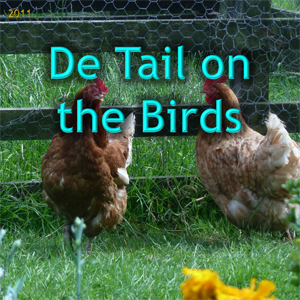 Article for 2011 Jul 31
Article for 2011 Jul 31
Part of the “De Tail on the Birds” series.
2011
Appendix

This was a monthly series of articles each focussing on a particular avian species I find interesting, though “Caledonia Gulls” features several species and is in poem form.
Jul 31 Sun “Chatterers and chatters”
Magpies are black and white, fly... unless they’ve had their wings clipped or are busy finding practical uses for mirrors. Magpies - corvids, just like crows, ravens, jays - are extremely intelligent, hence their apparent ability to recognise their reflection.
Magpies, Pica pica, are very common: in Europe are more than seven million magpies. Large population sizes, distinctive plumage, bold behaviour, and a distinctively long tail (half of entire length) have helped magpies to get into common folk-lore. Numerous superstitions concerning magpies exist in Western, Christian nations. The magpie is associated with the Devil, perhaps because the mixture of black, white, blue, and many different colours too is seen as impure. (However, there is a story that the magpie is black and white because its parents are a raven - black - and a dove - white. I’m not sure how well that fits with traditional ideas of doves being pure.) Also the boldness and curiosity of the magpie can be interpreted as arrogance.
Apparently two birds visited Jesus when he was being crucified. The magpie - adorned in splendid colours and fancy feathers - mocked Jesus; the robin meekly approached Him and sorrowfully removed His thorns, letting His blood dye its breast. Jesus blessed the robin, and cursed the magpie. So robins appear on Christmas cards, millennia later. And magpies still get their nests blown down in storms. I wrote that because in January 2007 a tree containing a magpie nest came down in my garden.
Some people are superstitious about magpies. Some such superstitions are suggested in the famous rhyme:
“One for sorrow; two for joy;
three for a girl; four for a boy;
five for silver; six for gold;
seven for a secret never to be told.”
Seven of course is the number of days in a week (thanks in part to the creation story in “Genesis”), and the number of animals of each species on board Noah’s Ark. Check the scripture if you don’t believe me. Seven is therefore a holy number, and, as magpies are “unholy”, seven magpies are never to be told (or seen).
(There is also a rhyme which goes “Clean birds in sevens, unclean in twos, the dove in the heavens is the one I choose”.)
However, in the Far East, traditional views of magpies are some-what different. In China, magpies are seen to bring happiness; their song predicting prosperity and love. In Mongolia, magpies are clever birds which control the weather. That is quite right!
Other references in culture to magpies include, in alphabetical order:
- the Magpie Brewery - makes beer in Nottinghamshire.
- Magpie Comms - a design and marketing agency.
- Magpie Cross-word Magazine - makers of puzzles.
They say that “Making A Good Puzzle Isn’t Easy”.
I reply: “My! Acronyms Generate Particularly Intense Envy!”. - the Magpies - nickname for the football team Newcastle United; their kit is black and white.
- MoneyMagpie.com - a price-comparison website.
- MusicMagpie.co.uk - a service that buys second- or third-hand CDs and computer-games.
- Magpie Recycling Ltd - a waste-disposal company in Brighton.
- Magpie Studio - a company that designs leaflets, I think.
- Magpie - a children’s television programme similar to Blue Peter, aired on ITV in the 1960s and 1970s.
As in MusicMagpie.com and Magpie Recycling Ltd, magpies are associated with taking things away. Allegedly they (the birds) steal shiny objects. As well as sparkling diamond rings, in the nest are things that magpies are proud of and sing of. The eggs are speckled, and when they hatch, what appears is such a fine brood, that one stops being broody.
To finish this article, I wish to make one thing clear. Magpies do not have a significant effect on the thrush population. (That’s “thrush” meaning the birds, not the fungal infection candidiasis.) And years ago I wrote a song about magpies, which you can read on my Poetry page. No, you can’t.
